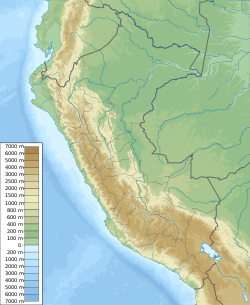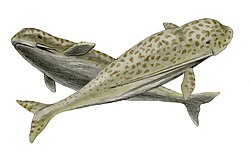Top Qs
Timeline
Chat
Perspective
Pisco Formation
Geologic formation in Peru From Wikipedia, the free encyclopedia
Remove ads
The Pisco Formation is a geologic formation located in Peru, on the southern coastal desert of Ica and Arequipa. The approximately 640 metres (2,100 ft) thick formation was deposited in the Pisco Basin, spanning an age from the Late Miocene up to the Early Pliocene, roughly from 9.6 to 4.5 Ma. The tuffaceous sandstones, diatomaceous siltstones, conglomerates and dolomites were deposited in a lagoonal to near-shore environment, in bays similar to other Pacific South American formations as the Bahía Inglesa and Coquimbo Formations of Chile.
The Pisco Formation is considered one of the most important Lagerstätten sites,[2][3] based on the large amount of exceptionally preserved marine fossils, including sharks (most notably megalodon), birds including penguins, whales and dolphins, marine crocodiles, and Thalassocnus, a marine giant sloths.[4]
Other famous fossils from this site include the giant raptorial sperm whale Livyatan,[5] the sperm whale relative Acrophyseter, and the walrus-like dolphin Odobenocetops.[6]
Remove ads
Description
The Pisco Formation of the Pisco Basin consists of tuffaceous sandstones, diatomaceous yellow to gray siltstones and a basal conglomerate.[7] The formation is deposited from Pisco in the north to Yauca in the south. The northern portion is known as the Ocucaje Area and the southern part as the Sacaco Area.[8] The total thickness of the formation is estimated at 640 metres (2,100 ft).[9] The formation unconformably overlies the Chilcatay and Caballas Formations.
Remove ads
Paleobiota of the Pisco Formation
Summarize
Perspective
The Pisco Formation has provided a rich resource of marine fauna, including marine mammals like cetaceans and seals, large fishes, reptiles, and penguins.[10] It is also one of the richest sites in the world for fossil cetaceans, with close to 500 examples being found in the formation.[11]
The oldest fossils of the aquatic sloth Thalassocnus (T. antiquus) come from the Aguada de Lomas horizon of the Pisco Formation and were dated at roughly 7 Ma. The youngest specimen (T. carolomartini) was found in the Sacaco horizon and dated to approximately 3 Ma.[12] Thalassocnus was preyed upon by the probable apex predators of the environment, Livyatan and megalodon.[13][14] The youngest strata belonging to the formation have been dated at 2 Ma, corresponding to the Early Pleistocene (Uquian). Fossils of the modern Humboldt penguin were found in these deposits at the Yauca locality.[15]
Birds
Fish
Bony fish
Rays
Sharks
Mammals
Cetaceans
Pinnipeds
- Seals
Xenarthrans
- Sloths
Mollusks
Bivalves
Polychaetes
Gastropods
Reptiles
Crocodilians
Turtles
Remove ads
Correlations
Laventan
See also
- Bahía Inglesa Formation, contemporaneous fossiliferous formation of Chile
- Castilletes Formation, contemporaneous fossiliferous formation of the Cocinetas Basin, Colombia
- Cerro Ballena, contemporaneous fossil site of the Bahía Inglesa Formation of Chile
- Coquimbo Formation, contemporaneous fossiliferous formation of Chile
- Collón Curá Formation, contemporaneous fossiliferous formation of Patagonia, Argentina
- Honda Group, contemporaneous fossiliferous formation of Colombia
- Navidad Formation, contemporaneous fossiliferous formation of Chile
- Pebas Formation, contemporaneous fossiliferous formation of the Amazon Basin
- Urumaco, contemporaneous fossil site of the Falcón Basin, Venezuela
Remove ads
References
Further reading
Wikiwand - on
Seamless Wikipedia browsing. On steroids.
Remove ads






























